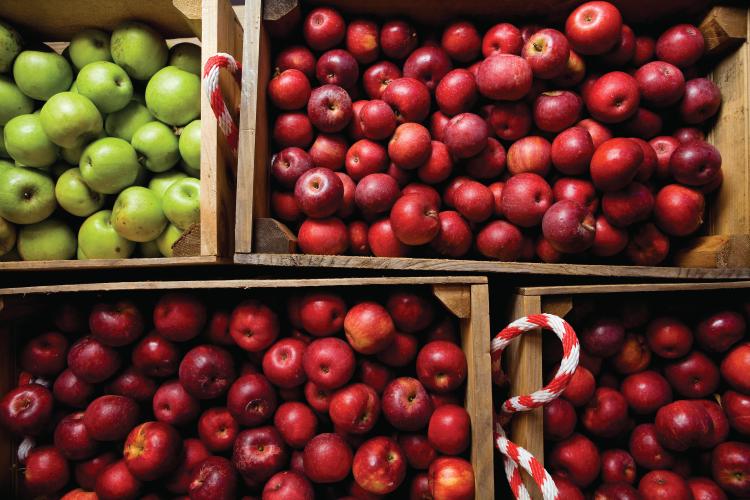Home > Michigan > Michigan Farm to Table > The Diversity of Michigan Agriculture
The Diversity of Michigan Agriculture
In partnership with: Michigan Department of Agriculture & Rural Development

Diversity is the name of the game for Michigan agriculture. With more than 300 different kinds of commodities produced, the state ranks second in the country as the most agriculturally diverse, after only California.
Hardworking farmers grow Michigan’s bounty of crops and commodities on 51,600 farms statewide. Operating across more than 9.9 million acres, each farm averages 193 acres. The work pays off too: Michigan’s combined food and agriculture industries contribute approximately $101.2 billion to the local economy each year.
Although production farmers are the backbone of the industry, Michigan food and agriculture also encompasses food processors and related industries, which employ 923,000 Michiganders. That’s a whopping 22 percent of the state’s workforce.
Michigan boasts an impressive variety of products and commodities, including milk, floriculture, corn, soybeans, fruits and vegetables, cattle, hogs, poultry, and sugarbeets. Additional![Michigan Agriculture 2017 [INFOGRAPHIC]](https://eadn-wc01-4177395.nxedge.io/wp-content/uploads/2020/05/Screen-Shot-2017-02-23-at-8.46.05-AM-300x320.jpg) ly, Michigan ranks first in the nation for production of begonias, blueberries, tart cherries, petunias, squash and more.
ly, Michigan ranks first in the nation for production of begonias, blueberries, tart cherries, petunias, squash and more.
Agriculture has a rich history in Michigan, and it’s easy to see why. Several major agricultural businesses have been in the state for 100 years or longer, and many family farms celebrate centennial status, where the land has been owned and operated by the same family for at least a century. Yet the industry has embraced change as well, with the number of young farmers, women and minority farmers growing over the past few decades.
Innovations in technology and sustainable practices – along with agricultural education, conservation, safety practices and new ideas – are all pieces that help Michigan food and agriculture continue to grow and thrive.

An Apple a Day
Take a bite out of a Michigan apple, the largest and most valuable fruit crop in the state. Michigan grows more than 11.3 million apple trees, producing the all-American fruit on 825 family-run farms. As the third-largest apple producer in the nation, uses for Michigan apples are split down the middle, with half of the crop sold fresh and ready to eat, while the rest are processed into other products, such as juice and applesauce.
Good news for apple lovers: Michigan apples are available almost year round, thanks to the state’s climate-controlled atmosphere storage. To help spread awareness about the important fruit, Michigan Apple Crunch Day is held each year in October, sharing agriculture’s heritage and information on apples with the community.
 Growing Strong
Growing Strong
Michigan is going green – with plants and flowers, that is. The state has an impressive greenhouse and nursery industry, with a combined economic impact of $5.7 billion. This includes perennial plant production, Christmas trees, sod producers, landscaping, and ornamental and vegetable plants.
The state has a total of 705 greenhouse operations, with Kalamazoo and Ottawa counties having the highest floriculture production in Michigan. The state consistently ranks in the top five production states in the nation, coming in fourth in 2014.
Learn more about Michigan’s always-growing industry through the Michigan Nursery and Landscape Association.
 Michigan Farm Fun
Michigan Farm Fun
From farmers markets and festivals to wine tastings, U-pick farms and corn mazes, Michigan’s agritourism offerings are vast. Agritourism destinations invite visitors to have a fun-filled day while simultaneously learning about Michigan agriculture and the hardworking farmers who grow their food.
![Michigan Agriculture 2017 [INFOGRAPHIC]](https://eadn-wc01-4177395.nxedge.io/wp-content/uploads/2020/05/Screen-Shot-2017-02-23-at-8.46.15-AM-1-188x320.jpg) Agritourism comes in all shapes and sizes, and it’s typically beneficial for the farmer, as well as the consumer, since it provides extra income in the off-season. Michigan is the second-most agriculturally diverse state in the country, so it makes sense that there is much to explore.
Agritourism comes in all shapes and sizes, and it’s typically beneficial for the farmer, as well as the consumer, since it provides extra income in the off-season. Michigan is the second-most agriculturally diverse state in the country, so it makes sense that there is much to explore.
In the spring and summer, the state offers U-pick berry farms, while fall is a perfect time to visit a pumpkin patch. Pick your own Christmas tree in the wintertime, and head to one of Michigan’s craft breweries or distilleries year round.
Ag in the City
In the past, farming conjured up visions of vast, open fields, with the closest skyscraper requiring a pretty substantial road trip. Today, things are changing as the urban agriculture movement grows. ![Michigan Agriculture 2017 [INFOGRAPHIC]](https://eadn-wc01-4177395.nxedge.io/wp-content/uploads/2020/05/Screen-Shot-2017-02-23-at-8.50.27-AM-320x293.jpg) In Michigan, organizations like the Michigan Urban Farming Initiative (MUFI) are bringing sustainable urban agriculture to the forefront by using it to promote education, community and sustainability. Located in Detroit, MUFI transformed a two-square-block area into a community garden, run completely by volunteers.
In Michigan, organizations like the Michigan Urban Farming Initiative (MUFI) are bringing sustainable urban agriculture to the forefront by using it to promote education, community and sustainability. Located in Detroit, MUFI transformed a two-square-block area into a community garden, run completely by volunteers.
Urban agriculture offers many benefits. A primary one is the ability to fight food insecurity – or unreliable access to enough nutritious, affordable food – in urban areas, where it’s often high. It also adds greenery and shade to city landscapes, and fosters community engagement while teaching urban residents more about where their food comes from.




[…] The state ranks second in the U.S. for agricultural diversity, with the industry contributing over $100 billion annually to the state economy. […]